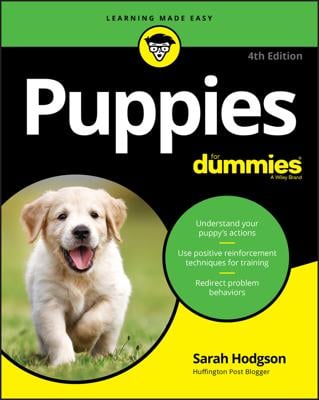For puppy’s homecoming, you'll want to choose a lightweight starter collar and leashes. Purchase a short, lightweight nylon leash (drag lead) for indoors and a long line for outdoor playtime in open areas (away from streets). You can purchase a lightweight adjustable cotton or nylon collar, called a buckle collar. Buckle collars don’t slide or choke. Their purpose is to carry your puppy’s ID tags.
Small-breed puppies are fragile, and their throats are particularly sensitive to the restraint of a collar. Although the collar is important for sporting an ID tag, if you have a small puppy, attach the leash to a harness instead of a collar.
Following are descriptions for the two main types of leashes for puppies:
Drag lead is a fancy term for a lightweight lead (leash) your puppy can drag behind her. This lightweight nylon leash stays on your puppy when you’re together in the house or yard so that you can restrain her for quick corrections that distance you from the activity, whether the activity be jumping on the counters, chewing a plant, or nipping at the kids. The indoor drag leash should be 4 feet long and be attached to your dog’s buckle collar or harness.
A long line is a 25- to 50-foot-long lead that allows your puppy freedom to play, and yet it also gives you plenty of leash to interfere with a rambunctious puppy and/or grab onto to retrieve your puppy if she should wander off. For young puppies, long lines are great for wandering in a yard or field — take along some favorite snacks and reward your puppy each time she checks in with you.
Microchips: Built-in lifesavers
Your veterinarian and breeder are likely to suggest that you microchip your puppy. Your veterinarian can inject into your puppy’s neck or shoulder (no more painful than a typical shot) a preregistered, computer-recognizable identification chip.
If your puppy gets lost or ends up at a shelter, a simple wave of the wand reads the embedded information (typically, your contact info) so that your puppy can be returned to you. Many breeders have a microchip inserted in each puppy’s shoulder before sending them home. If your pup hasn’t had a microchip inserted, make an appointment immediately.
ID tags for your puppy
When your puppy is conditioned to her collar, you can secure an ID tag to it. Some national-chain pet stores now have machines that create personalized tags in minutes. You can also find fancy ID tags online. Use an ID tag in addition to a microchip because people can’t identify the information on the microchip without the appropriate machinery.
A good message to include on the tag is “Need meds! Help me home [555-555-5555].” Of course your pup probably won’t need meds, but this message discourages would-be dog nappers and stresses the urgency of getting your puppy back home if someone finds her straying.

